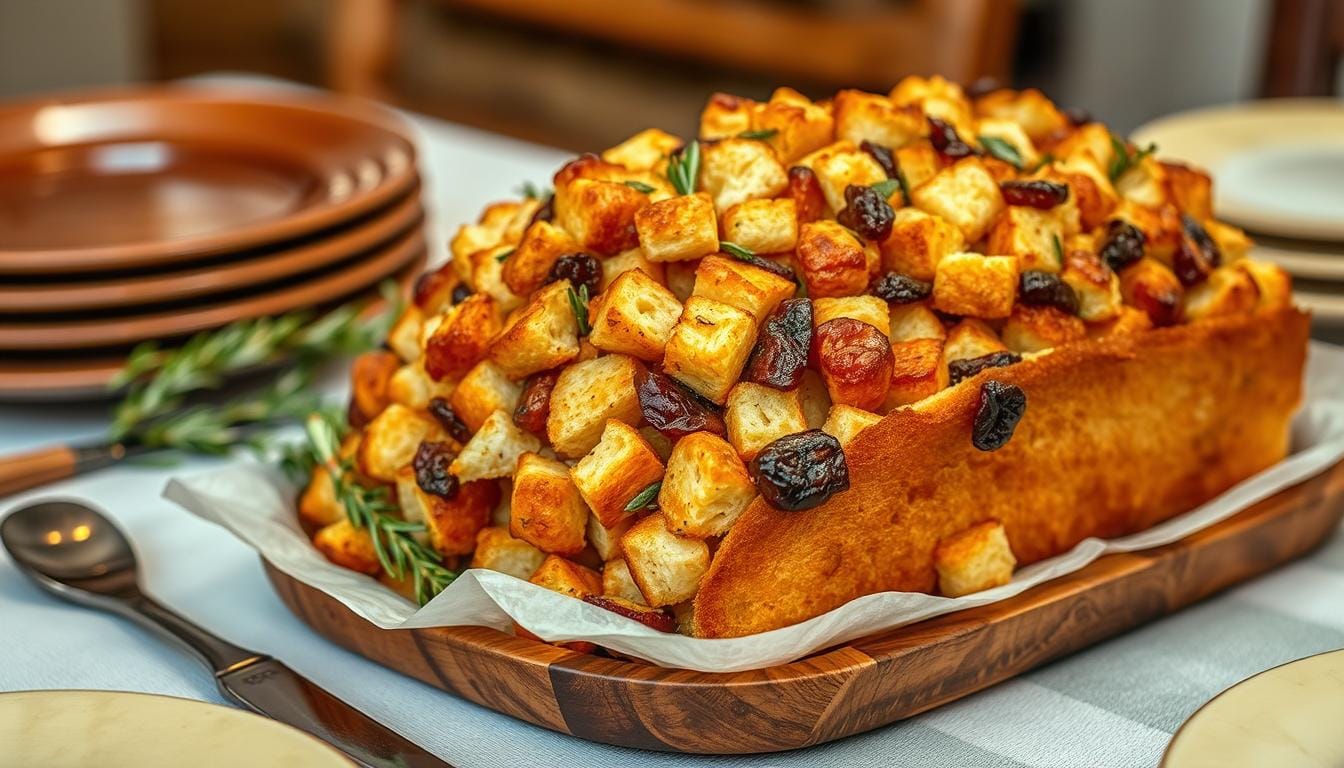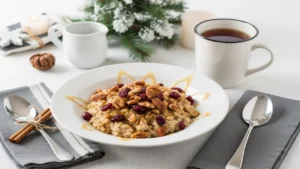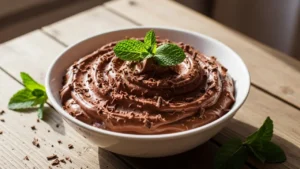Every Thanksgiving, my kitchen fills with the warm, savory smell of bread stuffing. It takes me back to happy memories of family gatherings. Making the perfect Thanksgiving sides is more than just following a recipe. It’s about creating special moments with loved ones.
Bread stuffing is more than a side dish. It’s a tradition that connects families across generations. Whether you’re an experienced cook or new to savory recipes, this classic herb bread stuffing will make your Thanksgiving meal unforgettable.
This year’s recipe combines traditional techniques with modern cooking tips. You’ll learn how to turn simple ingredients into a delicious dish that will be the highlight of your holiday. Get ready to discover the secrets of making a stuffing that’s crispy outside, tender inside, and full of flavor.
This guide will show you how to choose the right bread and mix herbs perfectly. You’ll learn every step to make a Thanksgiving stuffing that will impress your guests. They’ll ask for seconds and want the recipe.
Table of Contents
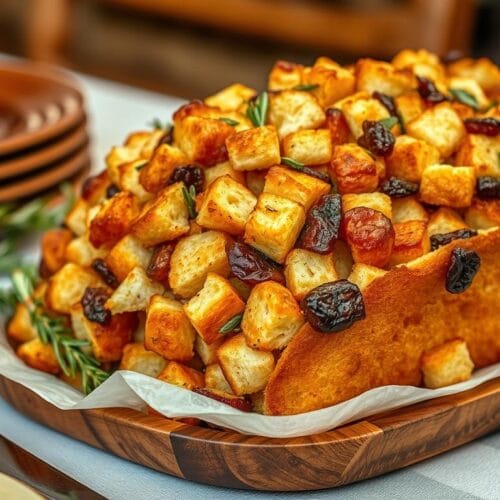
Classic Herb Bread Stuffing
Equipment
- Baking dish
- Large Skillet
- Mixing Bowl
- Wooden Spoon
- Measuring cups and spoons
- knife and cutting board
Ingredients
- 10 cups day-old bread cubes (sourdough, challah, or white)
- 1 cup chopped onion
- 1 cup chopped celery
- 3 cloves garlic, minced
- ½ cup unsalted butter or olive oil
- 2 cups chicken or vegetable broth (low sodium)
- 2 tbsp chopped fresh parsley
- 2 tsp fresh thyme leaves
- 1 tsp chopped fresh rosemary
- 1 tsp dried sage
- ½ tsp black pepper
- ½ tsp salt (adjust to taste)
- 1 egg, beaten (optional for binding)
Instructions
- Preheat oven to 375°F (190°C) and grease a baking dish.
- In a large skillet, melt butter over medium heat. Add onions, celery, and garlic. Sauté until softened, about 5–7 minutes.
- In a large bowl, combine bread cubes, sautéed vegetables, herbs, salt, and pepper. Toss to mix evenly.
- Slowly pour in the broth and beaten egg (if using), mixing gently until bread is moist but not soggy.
- Transfer the mixture to the prepared baking dish. Cover with foil and bake for 30 minutes.
- Remove foil and bake an additional 15–20 minutes until the top is golden and crisp.
- Let rest 5–10 minutes before serving. Garnish with extra herbs if desired.
Notes
Nutrition
What is Stuffing?
Stuffing is a tasty tradition that turns simple ingredients into a side dish loved at holiday meals. Your classic Christmas stuffing recipes share stories of cultural heritage and family traditions. These stories have been passed down for generations.
The history of stuffing goes back thousands of years. It started as a way to use up stale bread and make poultry taste better.
A Culinary Journey Through Time
Over time, stuffing has grown from a simple way to preserve food to a cherished dish. Ancient Romans wrote about stuffing in their cookbooks. This shows how important it has been in cooking for centuries.
“Stuffing is more than food—it’s a delicious connection to our culinary past.” – Culinary Historian
Global Stuffing Variations
Different cultures make stuffing in their own special ways. They use local ingredients and cooking traditions.
- Middle Eastern countries use rice and nuts in their stuffing
- British cuisine incorporates chestnuts and herbs
- Latin American regions often include spicy peppers
| Region | Primary Stuffing Ingredient | Unique Characteristic |
|---|---|---|
| United States | Bread Cubes | Sage and Thyme Seasoning |
| France | Chestnuts | Rich, Nutty Flavor |
| Greece | Rice | Mediterranean Herbs |
Your Christmas stuffing recipes can be inspired by these global traditions. This creates a unique culinary experience. It celebrates both heritage and creativity.
Essential Ingredients for Herb Bread Stuffing
Creating the perfect Stove Top Stuffing Recipes starts with the right ingredients. These ingredients turn simple bread into a delicious side dish. Choose them carefully for the best results.
Selecting the Perfect Bread Base
The base of any great stuffing is the bread. Look for bread that soaks up flavors well but stays firm. Good choices include:
- Sourdough for tangy depth
- Challah for rich, buttery texture
- Ciabatta for rustic character
- Day-old white bread for a classic taste
Fresh Herbs That Elevate Flavor
Aromatic herbs are key in Stovetop Stuffing Recipes. They can change the dish’s flavor completely.
| Herb | Flavor Profile | Best Pairings |
|---|---|---|
| Sage | Earthy, warm | Turkey, chicken |
| Thyme | Subtle, woodsy | Roasted meats |
| Rosemary | Intense, piney | Lamb, beef |
Texture-Enhancing Add-Ins
To make your Stove Top Stuffing Recipes stand out, add these ingredients:
- Toasted nuts for crunch
- Dried fruit for sweetness
- Crispy bacon bits
- Sautéed mushrooms
Preparing the Bread Base
The foundation of any classic stuffing recipe starts with the bread base. It’s key to turn regular bread into a delicious stuffing. This is how you make your Baked Stuffing a true masterpiece.
To make the bread base, you need to pay close attention. Certain techniques can take your Classic Stuffing Recipe to the next level.
Choosing the Right Bread
Not all breads are good for stuffing. You want bread that is:
- Firm and a day old for a sturdy texture
- Sourdough for a tangy taste
- Challah for a rich, eggy flavor
- Artisan white bread for a neutral taste
Drying Out the Bread
Drying the bread right is key to avoid sogginess. Here are three ways to do it:
- Let cubed bread air-dry overnight
- Use the oven at 250°F to dry it
- Try store-bought breadcrumbs for a quick fix
Cutting Techniques for Even Cooking
Evenly cut bread cubes are important for a consistent texture. Here’s how to do it:
| Cutting Method | Cube Size | Recommended Use |
|---|---|---|
| Knife Cutting | ½ to ¾ inch | Traditional stuffing texture |
| Food Processor | ¼ to ½ inch | Dense, compact stuffing |
| Hand Tearing | 1 to 1½ inch | Rustic, irregular texture |
Pro tip: Always ensure bread cubes are similar in size for even absorption and consistent baking.
By using these methods, you’ll make a bread base that turns your Baked Stuffing into a true culinary masterpiece.
Flavoring Your Stuffing
Creating memorable Stuffing Recipes For Thanksgiving starts with understanding how to build rich, complex flavors. The right combination of ingredients can transform your stuffing from ordinary to extraordinary. It becomes a standout dish at your holiday table.
Developing depth in your Stuffing Mix Recipes requires carefully selected ingredients. These ingredients work together to create a harmonious taste profile. Your goal is to craft a stuffing that complements the main course while standing out as a delicious side dish.
Using Aromatic Vegetables
Aromatic vegetables form the flavor foundation of exceptional stuffing. Consider these key ingredients:
- Onions: Provide a sweet, deep base flavor
- Celery: Adds a subtle, fresh crunch
- Garlic: Brings intense, savory notes
- Leeks: Offer a mild, sophisticated undertone
Importance of Broth in Stuffing
Broth plays a key role in creating moist, flavorful stuffing. Chicken or vegetable broth can elevate your recipe. It ensures the bread remains tender while infusing additional taste throughout the dish.
Spice Combinations for Depth of Flavor
Mastering spice blends can take your Stuffing Recipes For Thanksgiving to the next level. Consider these classic combinations:
- Sage and thyme: Traditional Thanksgiving herbs
- Rosemary and parsley: Fresh and aromatic
- Nutmeg and black pepper: Warm, subtle complexity
- Dried poultry seasoning: Convenient pre-mixed option
Remember, the secret to outstanding stuffing lies in balancing flavors. Experiment with ingredients that complement your personal taste preferences.
Techniques for Making Perfect Stuffing
Making the best Traditional Stuffing Recipes needs attention to detail. Whether it’s for a holiday or a family event, knowing the right steps can elevate your stuffing. It goes from good to great.
Perfect stuffing is all about balance. You want flavors, textures, and moisture just right. This way, everyone will want more.
Mixing Ingredients Thoroughly
When making Traditional Stuffing Recipes, mixing well is key. Here’s how to mix ingredients right:
- Use a big mixing bowl for easy mixing
- Fold ingredients gently to keep bread soft
- Make sure herbs and seasonings are spread out evenly
- Don’t overmix to avoid a dense stuffing
Moisture Levels: Getting it Just Right
Moisture is key in Turkey Dressing Recipes. Too little, and it’s dry; too much, and it’s soggy. Here’s how to get it just right:
- Add broth slowly, stirring between each addition
- Look for a moist but not wet texture
- Let it rest for 10-15 minutes to soak up liquid
- Check moisture by pressing a small part – it should hold together well
Baking Techniques for Optimal Crispness
To get a crispy top and a soft inside, bake at 375°F (190°C). Cover with foil for the first half to prevent too much browning.
Pro tip: For an extra crispy top, remove the foil during the last 15-20 minutes of baking.
By using these techniques, you’ll make a stuffing that’s a hit at any holiday meal.
Cooking Methods for Stuffing
Preparing stuffing for Thanksgiving is a fun process. You can use stovetop or baking methods to make it special. Each way has its own benefits for a tasty side dish.

The cooking method you choose affects the stuffing’s taste and texture. You can pick based on your kitchen, time, and taste.
Oven-Baked Stuffing Instructions
Baked stuffing is a favorite for many. Here’s how to make it perfect:
- Preheat your oven to 375°F
- Use a shallow baking dish for crispy edges
- Cover with foil for the first 30 minutes
- Uncover to create a golden-brown top
Slow Cooker Stuffing Technique
Slow cooker stuffing is great for busy days. It cooks the stuffing without much effort:
- Grease your slow cooker thoroughly
- Mix ingredients before adding to the cooker
- Cook on low for 3-4 hours
- Stir occasionally to prevent sticking
Inside-the-Turkey Stuffing Preparation
Cooking stuffing inside the turkey needs care. Always ensure the internal temperature reaches 165°F to prevent bacterial growth. This method can make cooking longer and affect the texture of both turkey and stuffing.
Serving Suggestions for Stuffing
Stuffing is more than just a side dish. It’s a star of your Thanksgiving meal. Whether you’re making traditional sides or looking for new ways to enjoy stuffing, these ideas will make your holiday dinner special.
Classic Thanksgiving Dish Pairings
Your stuffing is best with traditional Thanksgiving dishes. The right pairings make a plate that pleases everyone.
- Roasted turkey (the ultimate classic pairing)
- Cranberry sauce
- Savory gravy
- Roasted vegetables
- Mashed potatoes
Creative Serving Techniques
Make your Thanksgiving sides stand out with these creative ideas. Stuffing can be more than just a side dish.
- Create stuffing-filled stuffed mushrooms
- Use as a topping for roasted squash
- Craft stuffing-based appetizer balls
- Serve in individual ramekins for personalized portions
Leftover Stuffing Recipes
Leftover stuffing recipes are a great way to enjoy your Thanksgiving meal longer. These ideas turn leftover stuffing into exciting new dishes.
- Stuffing breakfast casserole
- Stuffing-crusted quiche
- Stuffed bell peppers with leftover stuffing
- Crispy stuffing patties
Pro tip: Always store leftover stuffing in an airtight container and consume within 3-4 days for the best flavor and safety.
Storage and Reheating Tips
Keeping your stuffing tasty means storing and reheating it right. This way, you can enjoy your holiday dish even after the main meal is over.
Best Practices for Storing Leftovers
Storing your stuffing right is key to keeping its flavor and texture. Here’s how to keep your Leftover Stuffing Recipes fresh:
- Cool stuffing completely before storing
- Use airtight containers to prevent moisture loss
- Refrigerate within two hours of cooking
- Store in shallow containers for even cooling
Reheating Methods to Preserve Flavor
To bring back your stuffing’s crispy edges and rich taste, reheating is important. Here are some good ways to do it:
| Reheating Method | Temperature | Time |
|---|---|---|
| Oven | 350°F | 15-20 minutes |
| Microwave | Medium power | 1-2 minutes |
| Skillet | Medium heat | 5-7 minutes |
Freezing Stuffing for Future Enjoyment
Freezing your stuffing is a great way to enjoy it later. Tip: Wrap tightly in freezer-safe containers or heavy-duty aluminum foil to prevent freezer burn.
“Great stuffing is a treasure worth preserving!” – Home Cooking Experts
Remember, stored stuffing can last 3-4 days in the fridge and up to 3 months in the freezer. Always check for spoilage before reheating and eating your Leftover Stuffing Recipes.
Common Mistakes to Avoid
Making the perfect Stuffing Recipes For Thanksgiving needs skill and focus. Many home cooks face challenges that can ruin their stuffing. Knowing these common mistakes can help you make a side dish that wows your guests.
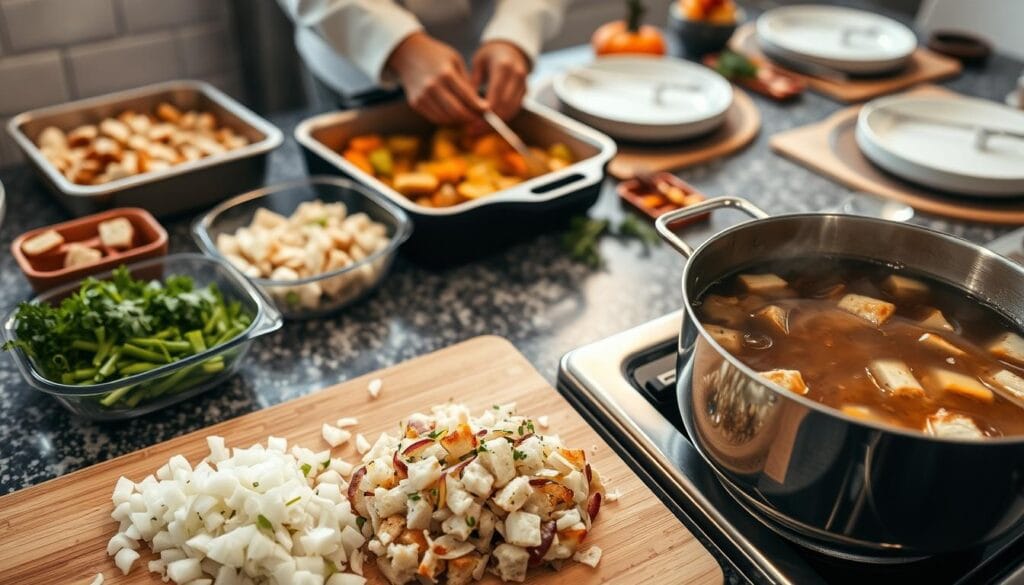
Creating a Classic Stuffing Recipe is more than just mixing ingredients. It’s an art that requires precision and care. Let’s look at the most common mistakes that can mess up your stuffing.
Moisture Matters: Avoiding the Soggy Stuffing Trap
Managing moisture is a big challenge in Stuffing Recipes For Thanksgiving. Too much liquid can turn your stuffing into a mushy mess. Here are some tips to avoid over-moistening:
- Use stale bread that absorbs liquid without becoming soggy
- Add broth gradually, checking consistency
- Let bread cubes dry out completely before mixing
Bread Cooking Challenges
Undercooked bread can ruin even the best Classic Stuffing Recipe. To get the perfect texture, follow these guidelines:
- Cut bread into uniform cubes
- Toast bread pieces before mixing
- Bake until golden brown and crispy edges form
Balancing Flavors Like a Pro
“Seasoning is the soul of any great stuffing recipe” – Professional Chef
Flavor imbalance can make your Stuffing Recipes For Thanksgiving taste bad. To avoid bland or overpowering stuffing, do the following:
- Use fresh herbs
- Tasting and adjusting seasonings
- Combining complementary ingredients
With these tips, you can turn stuffing disasters into a dish that everyone loves. It celebrates the art of holiday cooking.
Adapting Stuffing for Dietary Needs
Thanksgiving stuffing is a beloved tradition that everyone should enjoy, no matter their dietary restrictions. Traditional Stuffing Recipes can be easily modified to meet various dietary needs. This way, you don’t have to give up flavor or texture.
Crafting inclusive Stuffing Mix Recipes means understanding how to adapt classic preparations for different nutritional needs. The key is selecting alternative ingredients. These ingredients should keep the essence of traditional stuffing while meeting specific dietary constraints.
Gluten-Free Stuffing Solutions
For those avoiding gluten, several bread alternatives can transform your stuffing:
- Gluten-free cornbread
- Quinoa-based bread cubes
- Almond flour bread
- Rice-based bread alternatives
Vegetarian and Vegan Variations
Plant-based guests can enjoy delicious stuffing by replacing meat-based ingredients:
- Use vegetable broth instead of chicken stock
- Substitute butter with olive oil or vegan margarine
- Add mushrooms for umami flavor
- Incorporate roasted chestnuts for texture
Low-Sodium Alternatives
Reducing sodium doesn’t mean compromising taste. Consider these strategies:
- Use low-sodium vegetable broth
- Replace salt with herbs and spices
- Select fresh ingredients over processed ones
- Experiment with citrus zest for flavor enhancement
Pro tip: Always taste and adjust seasonings gradually when modifying Traditional Stuffing Recipes to ensure optimal flavor.
Creative Stuffing Variations to Try
Thanksgiving and Christmas stuffing recipes don’t have to be boring! Try new flavors to make your side dish exciting. Stuffing recipes for Thanksgiving are perfect for experimenting and impressing your guests.
Let your imagination run wild with unique ingredient combinations. This can turn your stuffing into something amazing. The trick is to mix flavors that work well together, keeping the comfort of a traditional recipe.
Seasonal Ingredient Swaps
Seasonal ingredients can make your stuffing recipe fresh. Here are some swap ideas:
- Replace traditional bread with cornbread for a Southern twist
- Add roasted butternut squash for a fall-inspired flavor
- Incorporate wild mushrooms for an earthy undertone
- Mix in dried cranberries for a touch of sweetness
International Flavors for a Twist
Global cuisine is great for stuffing variations. Try these international flavors:
- Spanish-style stuffing with chorizo and smoked paprika
- Mediterranean version with olives and feta cheese
- Asian-inspired stuffing with water chestnuts and ginger
Sweet and Savory Concoctions
Blending sweet and savory elements can make your stuffing memorable. Try these unique combinations:
- Apple and sage stuffing with caramelized onions
- Pecan and brown sugar blend with rosemary
- Maple-glazed sausage stuffing
“Cooking is about passion, so don’t be afraid to experiment with your stuffing!” – Professional Chef
The best stuffing recipes come from creative experimentation. Your holiday table deserves a side dish that tells a unique story.
Conclusion: Perfecting Your Stuffing Recipe
Your journey through traditional stuffing recipes doesn’t end here. To make the perfect turkey dressing, you need practice, passion, and a desire to try new things. Every Thanksgiving is a chance to get better and make something special for your loved ones.
Making stuffing is more than just following a recipe. It’s about learning how flavors mix and ingredients work together. Whether you stick to a classic or try something new, remember that cooking is a way to express yourself. Your turkey dressing recipes can become family traditions that last for years.
Key Takeaways to Remember
Begin with the best ingredients and feel free to change recipes to fit your taste. Using fresh herbs, choosing the right bread, and controlling moisture are key to a great stuffing. Each time you make it, you’ll get better and make Thanksgiving even more special.
Your Culinary Adventure Continues
Keep trying new things and mixing different ingredients. The best stuffing recipes come from being creative and trying new things. When you cook with passion and love, your Thanksgiving table will always be unforgettable.

